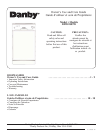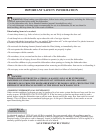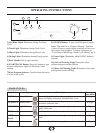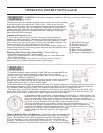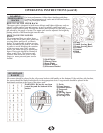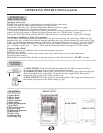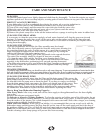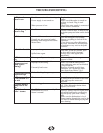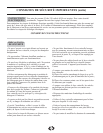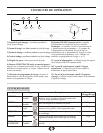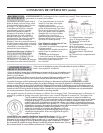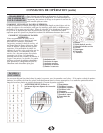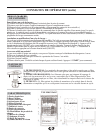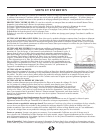
4
OPERATING INSTRUCTIONS (cont’d)
DETERGENT
DISPENSER
The dispenser must be refilled before the start of each wash cycle according
to the instructions provided in the “Wash Cycles” table on the previous
page. Your dishwasher uses less detergent and rinse aid than conventional
dishwashers. Generally, only one tablespoon of detergent is needed for a
normal wash load. More heavily soiled items need more detergent. Always
add the detergent just before starting dishwasher, otherwise it could get
damp and not dissolve properly.
Amount of Detergent to Use:
If your water is not too hard, you may also prevent the formation of
deposits by adding detergent. The amount of detergent needed can vary due
to differences in water hardness. To determine the water hardness in your
area, contact your local water utility or area water softening company. The
harder your water, the more detergent you may need.
• Use only detergent specifically made for use in dishwashers. Keep your
detergent fresh and dry. Don’t put powder detergent into the dispenser until
you are ready to wash dishes.
Removing Hard Water Spots From Dishes- Try the following:
• Run dishes through a normal wash program.
• Remove all metal dishware, such as cutlery, pans etc. from dishwasher.
• Do not add detergent.
• Pour 2 cups of vinegar into a bowl, set it face up on lower rack of
dishwasher and run dishes through normal wash program.
1) Main Wash Detergent
2) Dispenser Lid Lever
3) Prewash Detergent
Compartment
4) Rinse Aid Level Indicator
5) Rinse Aid Compartment
6) Detergent Compartment Lid
WARNING: Dishwasher detergent is corrosive! Take care to keep out of the reach of
children.
RINSE AID
DISPENSER
• To open the dispenser, turn the cap to the “open” (left arrow) position and lift out.
• Pour the rinse aid into the dispenser, being careful not to overfill.
• Replace the cap by inserting it aligned with “open” arrow and turning it to
the “closed” (right arrow) position.
The rinse aid is released during the final rinse to prevent water from forming
droplets on your dishes that can leave spots and streaks. It also improves
drying by allowing water to "sheet" off the dishes.
• Your dishwasher is designed to use liquid rinse aids. The rinse aid dispenser is located inside the door next to
the detergent dispenser. To fill the dispenser, open the cap and pour the rinse aid into the dispenser until the
level indicator turns completely black. The dispenser holds about 100 ml of liquid rinse aid.
• Be careful not to overfill the dispenser, because this could cause over sudsing. Wipe away any spills with a
damp cloth. Don't forget to replace the cap before you close the dishwasher door.If you have soft water, you
may not need rinse aid as it may cause a white film to develop on your dishes.
A measured amount of rinse aid is released during the final rinse. As with detergent, the
amount of rinse aid needed for your dishes depends on the hardness of the water in your
area. Too much rinse aid can result in lather or foaming and can cause cloudiness or
streaks on your dishes. If the water in your area is very soft, you may not need rinse aid.
If you do, you can dilutethe rinse aid with an equal amount of water.
The rinse aid dispenser has six settings. Always start with the dispenser set on " 1 ". If
spots and poor drying are problems, increase the amount of rinse aid dispensed by
removing the dispenser lid and rotating the dial to "2". If the dishes still are not drying
properly or are spotted, adjust the dial to the next higher
number until your dishes are spot-free. We suggest the
setting of "4".
When to Refill the Rinse Aid Dispenser: If there is no rinse aid warning light
on the control panel, you can judge the amount of rinse aid by the following
means. The black dot on the rinse aid dispenser indicates the amount of rinse
aid in the dispenser. As the rinse aid diminishes, the size of the black dot
decreases. You should never let the rinse aid get below 1 / 4 full. As the rinse
aid diminishes, the size of the black dot on the rinse aid level indicator changes:
Full 1/4 full (Refill)
3/4 Full Empty
1/2 Full



